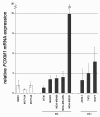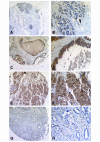Tight correlation between expression of the Forkhead transcription factor FOXM1 and HER2 in human breast cancer
- PMID: 18254960
- PMCID: PMC2265720
- DOI: 10.1186/1471-2407-8-42
Tight correlation between expression of the Forkhead transcription factor FOXM1 and HER2 in human breast cancer
Abstract
Background: FOXM1 regulates expression of cell cycle related genes that are essential for progression into DNA replication and mitosis. Consistent with its role in proliferation, elevated expression of FOXM1 has been reported in a variety of human tumour entities. FOXM1 is a gene of interest because recently chemical inhibitors of FOXM1 were described to limit proliferation and induce apoptosis in cancer cells in vitro, indicating that FOXM1 inhibitors could represent useful anticancer therapeutics.
Methods: Using immunohistochemistry (IHC) we systematically analysed FOXM1 expression in human invasive breast carcinomas (n = 204) and normal breast tissues (n = 46) on a tissue microarray. Additionally, using semiquantitative realtime PCR, a collection of paraffin embedded normal (n = 12) and cancerous (n = 25) breast tissue specimens as well as benign (n = 3) and malignant mammary cell lines (n = 8) were investigated for FOXM1 expression. SPSS version 14.0 was used for statistical analysis.
Results: FOXM1 was found to be overexpressed in breast cancer in comparison to normal breast tissue both on the RNA and protein level (e.g. 8.7 fold as measured by realtime PCR). We found a significant correlation between FOXM1 expression and the HER2 status determined by HER2 immunohistochemistry (P < 0.05). Univariate survival analysis showed a tendency between FOXM1 protein expression and unfavourable prognosis (P = 0.110).
Conclusion: FOXM1 may represent a novel breast tumour marker with prognostic significance that could be included into multi-marker panels for breast cancer. Interestingly, we found a positive correlation between FOXM1 expression and HER2 status, pointing to a potential role of FOXM1 as a new drug target in HER2 resistant breast tumour, as FOXM1 inhibitors for cancer treatment were described recently. Further studies are underway to analyse the potential interaction between FOXM1 and HER2, especially whether FOXM1 directly activates the HER2 promoter.
Figures




References
-
- Kaestner KH, Knochel W, Martinez DE. Unified nomenclature for the winged helix/forkhead transcription factors. Genes Dev. 2000;14:142–6. - PubMed
Publication types
MeSH terms
Substances
LinkOut - more resources
Full Text Sources
Other Literature Sources
Medical
Research Materials
Miscellaneous

